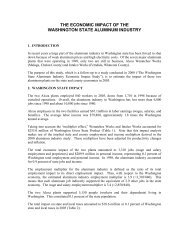WORLD POPULATION TO 2300
WORLD POPULATION TO 2300
WORLD POPULATION TO 2300
You also want an ePaper? Increase the reach of your titles
YUMPU automatically turns print PDFs into web optimized ePapers that Google loves.
Population (billions)<br />
11<br />
10<br />
9<br />
8<br />
7<br />
6<br />
5<br />
4<br />
3<br />
2.5<br />
Figure 1. Estimated world population, 1950-2000, and projections: 2000-2050<br />
High<br />
Medium<br />
Low<br />
2<br />
1950 1960 1970 1980 1990 2000 2010 2020 2030 2040 2050<br />
Average annual rates of population change<br />
show that Africa has experienced considerably<br />
faster growth than any other major area, for most<br />
of the 1950-2000 period (figure 2). Growth rates<br />
reached a higher peak in Africa (2.86 per cent)<br />
than anywhere else—in the early 1980s, at least<br />
15 years after growth had begun to decline in<br />
every other major area. The projection for Africa,<br />
consequently, shows growth declining belatedly,<br />
though nevertheless following a downward path<br />
similar to that in other major areas. Europe is at<br />
the other end of the spectrum, with growth rates<br />
having just turned negative and continuing to fall<br />
up to 2050.<br />
Though growth rates are at different levels,<br />
their decline is projected to be similar across major<br />
areas. The more developed regions show<br />
slightly slower decline in growth rates than the<br />
less developed regions, mainly because of international<br />
migration. If net migration were set to zero,<br />
the lines would be more nearly parallel. International<br />
migration is particularly important for<br />
Northern America (i.e., the United States and<br />
Canada), accounting for 0.5 percentage points<br />
of the growth rate for 2000-2050. For Europe,<br />
6.1<br />
migration boosts the growth rate by 0.1-0.2 points,<br />
and for Oceania by around 0.25 points. (For Australia<br />
alone, migration adds about twice that to the<br />
growth rate.)<br />
Growth rate declines are parallel (international<br />
migration aside) largely because assumptions<br />
about fertility change are similar. Figure 3 shows<br />
the substantial gap that currently exists—but is<br />
projected to narrow—between total fertility in<br />
Africa and total fertility in every other major area.<br />
A gap in fertility levels also exists between the<br />
other major areas of the world, but by 2050 levels<br />
are expected to converge in a narrow band between<br />
1.84 and 1.92 children per woman. Europe<br />
will take the longest to enter this band, and will do<br />
so through rising fertility, in contrast to falling<br />
fertility in other major areas.<br />
Mortality exerts some additional influence on<br />
the growth rate. Across major areas, its effect on<br />
growth largely counteracts that of fertility, since<br />
where fertility is higher, mortality also tends to be<br />
higher. Over time, life expectancy is expected to<br />
rise fairly smoothly.<br />
United Nations Department of Economic and Social Affairs/Population Division 5<br />
World Population to <strong>2300</strong><br />
10.6<br />
8.9<br />
7.4





